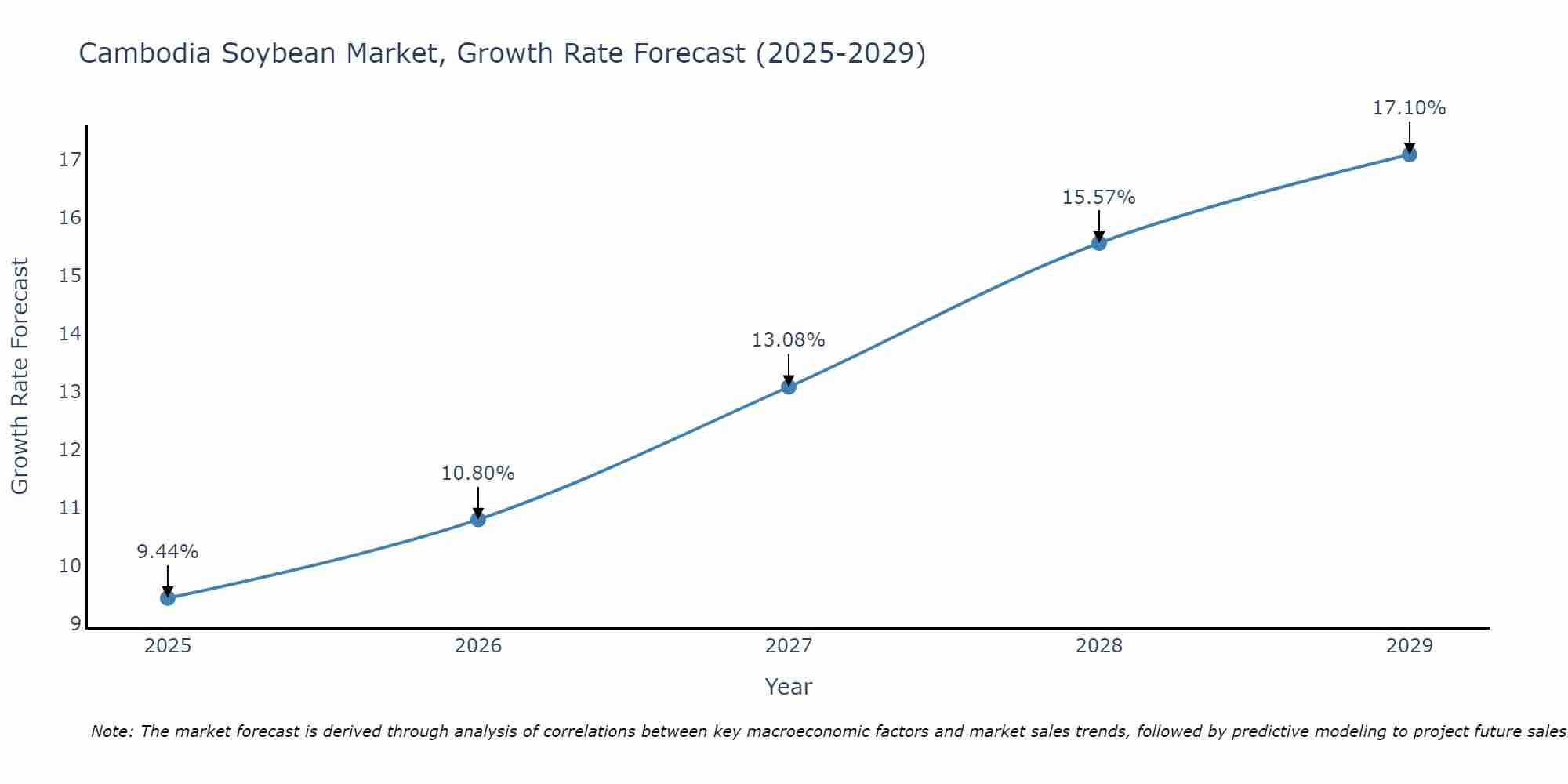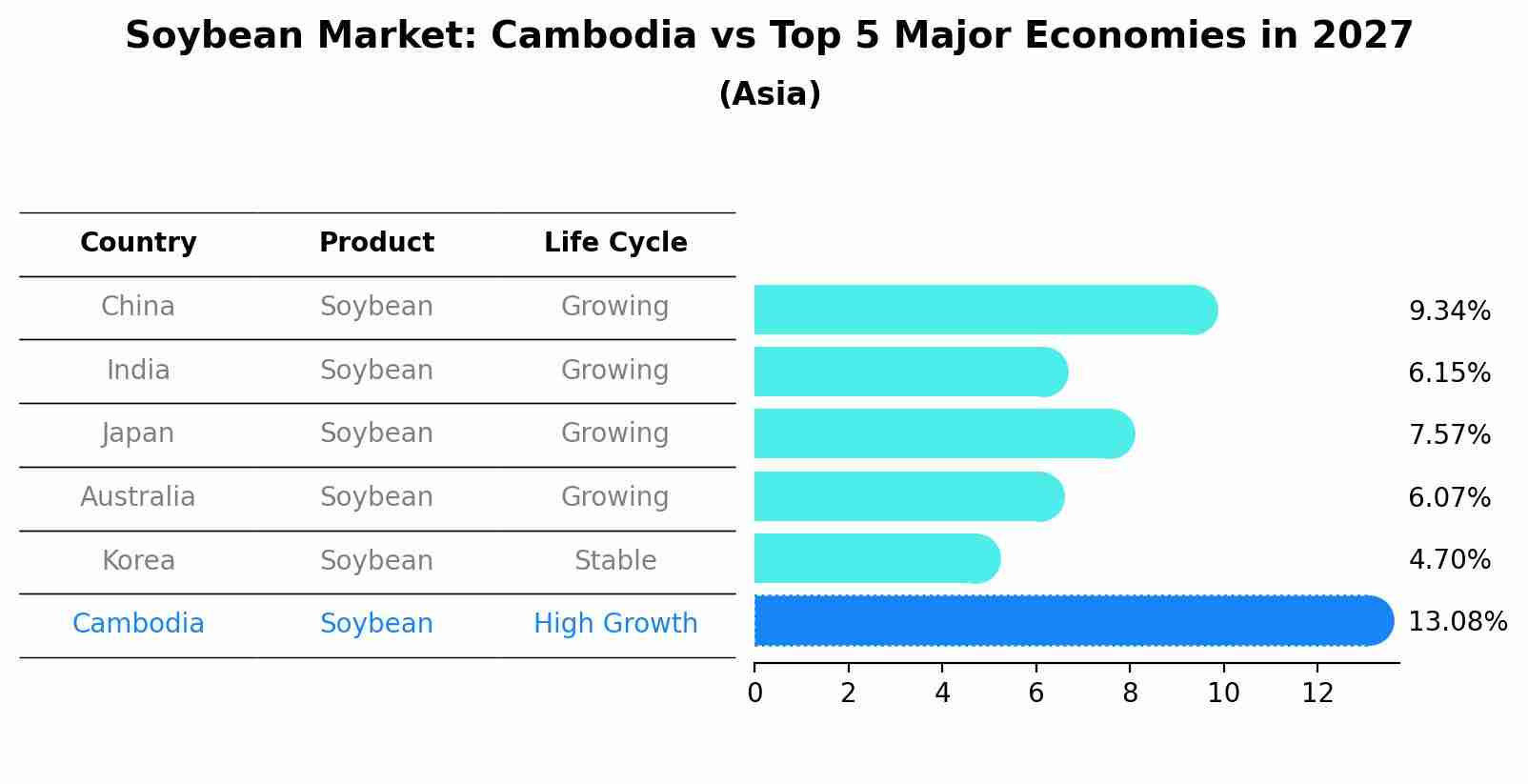Cambodia Soybean Market Outlook | Companies, Share, Analysis, Revenue, Growth, Size, Value, Forecast, Trends, Industry & COVID-19 IMPACT
| Product Code: ETC224673 | Publication Date: Aug 2022 | Updated Date: Aug 2025 | Product Type: Market Research Report | |
| Publisher: 6Wresearch | Author: Sachin Kumar Rai | No. of Pages: 75 | No. of Figures: 35 | No. of Tables: 20 |
Cambodia Soybean Market Size Growth Rate
The Cambodia Soybean Market is likely to experience consistent growth rate gains over the period 2025 to 2029. From 9.44% in 2025, the growth rate steadily ascends to 17.10% in 2029.

Soybean Market: Cambodia vs Top 5 Major Economies in 2027 (Asia)
Cambodia's Soybean market is anticipated to experience a high growth rate of 13.08% by 2027, reflecting trends observed in the largest economy China, followed by India, Japan, Australia and South Korea.

Cambodia Soybean Market Overview
The Cambodia Soybean Market is experiencing steady growth due to increasing demand for soy products in the country. Soybeans are primarily imported to meet the domestic demand for soybean oil, soy milk, and tofu. The market is driven by factors such as the growing awareness of the health benefits of soy products, changing dietary preferences, and the expansion of the food processing industry. However, the market faces challenges such as fluctuations in global soybean prices, limited domestic production, and competition from other edible oils. As a result, there is a growing focus on increasing local soybean cultivation to reduce dependency on imports and ensure a stable supply chain. Overall, the Cambodia Soybean Market presents opportunities for both domestic producers and international suppliers looking to capitalize on the growing demand for soy products in the country.
Cambodia Soybean Market Trends
The Cambodia soybean market is experiencing a growing demand due to increasing awareness about the health benefits of soy products. Consumers are incorporating soy-based products such as tofu, soy milk, and soy sauce into their diets as a source of protein and as a healthier alternative to traditional options. Additionally, the food industry in Cambodia is utilizing soybean ingredients in various processed foods to meet the demand for healthier and more nutritious options. The government`s initiatives to promote soybean cultivation and production within the country are also contributing to the growth of the market. As a result, there is a rising interest from both consumers and businesses in the Cambodia soybean market, indicating a positive trend towards the expansion of the industry.
Cambodia Soybean Market Challenges
In the Cambodia soybean market, challenges include limited domestic production leading to high dependency on imports, inconsistent quality of imported soybeans, fluctuating global prices impacting local market stability, lack of infrastructure for storage and transportation, inadequate technical knowledge among local farmers for soybean cultivation, and competition from other popular crops such as rice and corn. Additionally, there are constraints related to government policies, trade regulations, and access to affordable financing for farmers. These challenges collectively hinder the growth and development of the soybean market in Cambodia, requiring strategic solutions and support from stakeholders to improve production, quality control, market access, and overall sustainability of the industry.
Cambodia Soybean Market Investment Opportunities
The Cambodia soybean market presents promising opportunities for investors due to the increasing demand for soybean products in the country. With a growing population and rising awareness about the health benefits of soy-based products, there is a growing market for soybeans and soybean-derived products such as tofu, soy milk, and soybean oil. Investing in soybean cultivation or processing facilities in Cambodia could be a lucrative venture, as the country currently relies heavily on imports to meet its soybean demand. Additionally, the Cambodian government has been implementing policies to support agricultural development, further enhancing the investment potential in the soybean market. Overall, investing in the Cambodia soybean market could offer attractive returns for investors looking to capitalize on the growing demand for soy products in the country.
Cambodia Soybean Market Government Policy
The Cambodian government has implemented various policies to support the soybean market, including promoting domestic soybean production to reduce reliance on imports and boost self-sufficiency. The government provides subsidies and incentives to farmers to increase soybean cultivation, as well as offers technical assistance and training programs to improve crop yields. Additionally, there are initiatives in place to enhance the supply chain infrastructure, such as storage facilities and transportation networks, to facilitate the distribution of soybeans across the country. Furthermore, the government has regulations in place to ensure quality standards and food safety measures are met in the soybean market, aiming to protect consumer health and promote market competitiveness. Overall, these policies are aimed at developing a sustainable and thriving soybean market in Cambodia.
Cambodia Soybean Market Future Outlook
The future outlook for the Cambodia Soybean Market appears positive due to increasing demand for soy products driven by changing dietary preferences and awareness of the health benefits associated with soy consumption. The market is expected to witness growth in both production and consumption as farmers receive more support and resources to cultivate soybeans, leading to improved yields. Additionally, the government`s efforts to promote soybean cultivation as part of the country`s agricultural development strategy are likely to further boost market growth. With a growing population and rising disposable incomes, the Cambodia Soybean Market is poised for expansion in the coming years, presenting opportunities for both domestic producers and international suppliers to meet the rising demand.
Key Highlights of the Report:
- Cambodia Soybean Market Outlook
- Market Size of Cambodia Soybean Market, 2021
- Forecast of Cambodia Soybean Market, 2031
- Historical Data and Forecast of Cambodia Soybean Revenues & Volume for the Period 2018 - 2031
- Cambodia Soybean Market Trend Evolution
- Cambodia Soybean Market Drivers and Challenges
- Cambodia Soybean Price Trends
- Cambodia Soybean Porter's Five Forces
- Cambodia Soybean Industry Life Cycle
- Historical Data and Forecast of Cambodia Soybean Market Revenues & Volume By Applications for the Period 2018 - 2031
- Historical Data and Forecast of Cambodia Soybean Market Revenues & Volume By Crush for the Period 2018 - 2031
- Historical Data and Forecast of Cambodia Soybean Market Revenues & Volume By Feed Use for the Period 2018 - 2031
- Historical Data and Forecast of Cambodia Soybean Market Revenues & Volume By Food Use for the Period 2018 - 2031
- Cambodia Soybean Import Export Trade Statistics
- Market Opportunity Assessment By Applications
- Cambodia Soybean Top Companies Market Share
- Cambodia Soybean Competitive Benchmarking By Technical and Operational Parameters
- Cambodia Soybean Company Profiles
- Cambodia Soybean Key Strategic Recommendations
Frequently Asked Questions About the Market Study (FAQs):
1 Executive Summary |
2 Introduction |
2.1 Key Highlights of the Report |
2.2 Report Description |
2.3 Market Scope & Segmentation |
2.4 Research Methodology |
2.5 Assumptions |
3 Cambodia Soybean Market Overview |
3.1 Cambodia Country Macro Economic Indicators |
3.2 Cambodia Soybean Market Revenues & Volume, 2021 & 2031F |
3.3 Cambodia Soybean Market - Industry Life Cycle |
3.4 Cambodia Soybean Market - Porter's Five Forces |
3.5 Cambodia Soybean Market Revenues & Volume Share, By Applications, 2021 & 2031F |
4 Cambodia Soybean Market Dynamics |
4.1 Impact Analysis |
4.2 Market Drivers |
4.2.1 Increasing demand for protein-rich food products in Cambodia |
4.2.2 Government support and initiatives to promote soybean cultivation |
4.2.3 Growing health consciousness and awareness about the benefits of soybean consumption |
4.3 Market Restraints |
4.3.1 Lack of advanced technology and infrastructure for soybean cultivation and processing |
4.3.2 Dependence on imports due to limited domestic production capacity |
4.3.3 Price volatility in the global soybean market impacting local prices |
5 Cambodia Soybean Market Trends |
6 Cambodia Soybean Market, By Types |
6.1 Cambodia Soybean Market, By Applications |
6.1.1 Overview and Analysis |
6.1.2 Cambodia Soybean Market Revenues & Volume, By Applications, 2021-2031F |
6.1.3 Cambodia Soybean Market Revenues & Volume, By Crush, 2021-2031F |
6.1.4 Cambodia Soybean Market Revenues & Volume, By Feed Use, 2021-2031F |
6.1.5 Cambodia Soybean Market Revenues & Volume, By Food Use, 2021-2031F |
7 Cambodia Soybean Market Import-Export Trade Statistics |
7.1 Cambodia Soybean Market Export to Major Countries |
7.2 Cambodia Soybean Market Imports from Major Countries |
8 Cambodia Soybean Market Key Performance Indicators |
8.1 Percentage increase in soybean cultivation area in Cambodia |
8.2 Adoption rate of modern agricultural practices in soybean cultivation |
8.3 Number of local soybean processing facilities established |
8.4 Consumer awareness and consumption of soybean products in Cambodia |
8.5 Percentage of soybean import substitution achieved |
9 Cambodia Soybean Market - Opportunity Assessment |
9.1 Cambodia Soybean Market Opportunity Assessment, By Applications, 2021 & 2031F |
10 Cambodia Soybean Market - Competitive Landscape |
10.1 Cambodia Soybean Market Revenue Share, By Companies, 2021 |
10.2 Cambodia Soybean Market Competitive Benchmarking, By Operating and Technical Parameters |
11 Company Profiles |
12 Recommendations |
13 Disclaimer |
- Single User License$ 1,995
- Department License$ 2,400
- Site License$ 3,120
- Global License$ 3,795
Search
Thought Leadership and Analyst Meet
Our Clients
Related Reports
- Afghanistan Apparel Market (2026-2032) | Growth, Outlook, Industry, Segmentation, Forecast, Size, Companies, Trends, Value, Share, Analysis & Revenue
- Canada Oil and Gas Market (2026-2032) | Share, Segmentation, Value, Industry, Trends, Forecast, Analysis, Size & Revenue, Growth, Competitive Landscape, Outlook, Companies
- Germany Breakfast Food Market (2026-2032) | Industry, Share, Growth, Size, Companies, Value, Analysis, Revenue, Trends, Forecast & Outlook
- Australia Briquette Market (2025-2031) | Growth, Size, Revenue, Forecast, Analysis, Trends, Value, Share, Industry & Companies
- Vietnam System Integrator Market (2025-2031) | Size, Companies, Analysis, Industry, Value, Forecast, Growth, Trends, Revenue & Share
- ASEAN and Thailand Brain Health Supplements Market (2025-2031) | Strategy, Consumer Insights, Analysis, Investment Trends, Opportunities, Growth, Size, Share, Industry, Revenue, Segments, Value, Segmentation, Supply, Forecast, Restraints, Outlook, Competition, Drivers, Trends, Demand, Pricing Analysis, Competitive, Strategic Insights, Companies, Challenges
- ASEAN Bearings Market (2025-2031) | Strategy, Consumer Insights, Analysis, Investment Trends, Opportunities, Growth, Size, Share, Industry, Revenue, Segments, Value, Segmentation, Supply, Forecast, Restraints, Outlook, Competition, Drivers, Trends, Demand, Pricing Analysis, Competitive, Strategic Insights, Companies, Challenges
- Europe Flooring Market (2025-2031) | Outlook, Share, Industry, Trends, Forecast, Companies, Revenue, Size, Analysis, Growth & Value
- Saudi Arabia Manlift Market (2025-2031) | Outlook, Size, Growth, Trends, Companies, Industry, Revenue, Value, Share, Forecast & Analysis
- Uganda Excavator, Crane, and Wheel Loaders Market (2025-2031) | Strategy, Consumer Insights, Analysis, Investment Trends, Opportunities, Growth, Size, Share, Industry, Revenue, Segments, Value, Segmentation, Supply, Forecast, Restraints, Outlook, Competition, Drivers, Trends, Demand, Pricing Analysis, Competitive, Strategic Insights, Companies, Challenges
Industry Events and Analyst Meet
Whitepaper
- Middle East & Africa Commercial Security Market Click here to view more.
- Middle East & Africa Fire Safety Systems & Equipment Market Click here to view more.
- GCC Drone Market Click here to view more.
- Middle East Lighting Fixture Market Click here to view more.
- GCC Physical & Perimeter Security Market Click here to view more.
6WResearch In News
- Doha a strategic location for EV manufacturing hub: IPA Qatar
- Demand for luxury TVs surging in the GCC, says Samsung
- Empowering Growth: The Thriving Journey of Bangladesh’s Cable Industry
- Demand for luxury TVs surging in the GCC, says Samsung
- Video call with a traditional healer? Once unthinkable, it’s now common in South Africa
- Intelligent Buildings To Smooth GCC’s Path To Net Zero


















